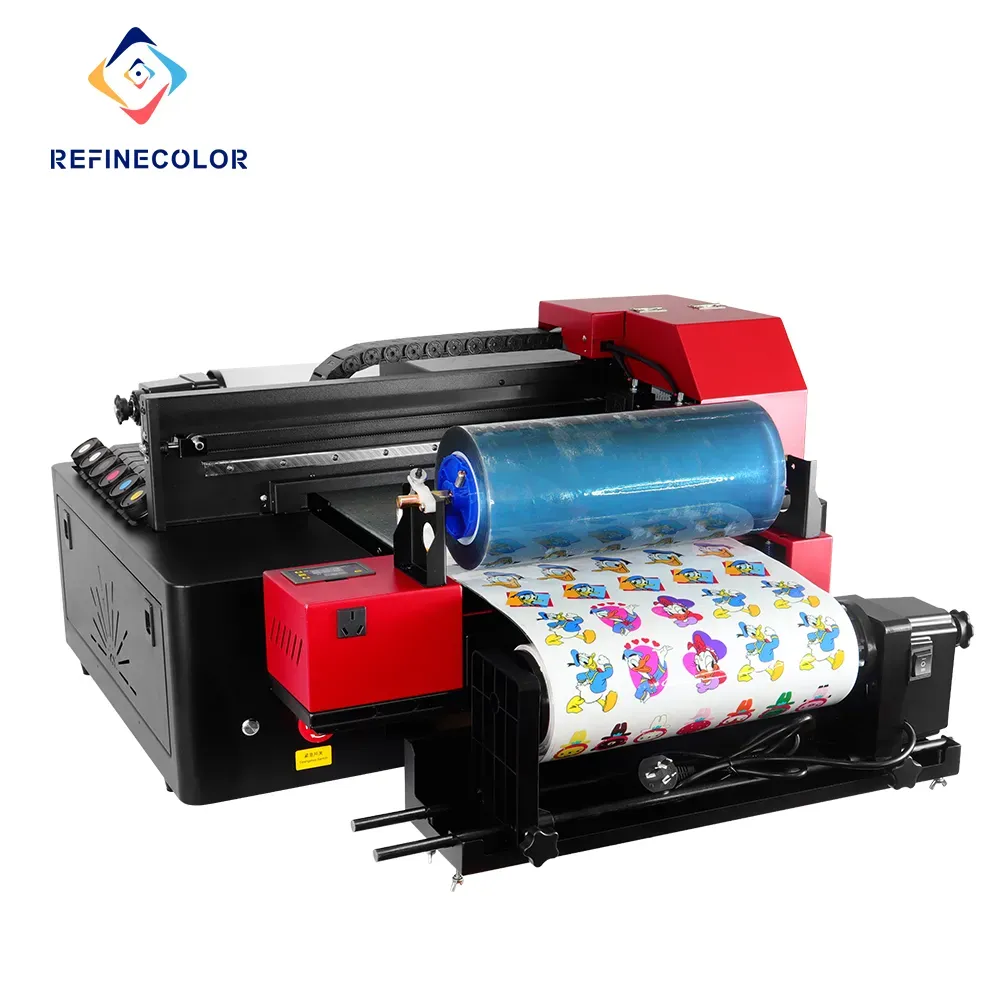**UV DTF**, or Ultraviolet Direct to Film, represents a revolutionary advancement in the world of printing technology. By harnessing the power of UV printing, this state-of-the-art method allows for vibrant and detailed images to be printed directly onto film using a unique photopolymerization process. One of the standout advantages of UV DTF technology is its ability to produce high-quality prints almost instantly, which enables businesses to meet the growing demands for quick turnaround times. Moreover, this sustainable printing solution is eco-friendly, utilizing inks that are not only durable but also minimize environmental impact. In this article, we will explore the intricacies of UV DTF, uncovering the benefits and processes that make it a preferred choice for modern printing applications.
Also known as Ultraviolet Direct to Film printing, this innovative printing technique leverages the efficiency of direct-to-film technology combined with the curing capabilities of UV light. This process is characterized by its use of photoinitiators to achieve rapid curing, which results in stunningly colorful and durable prints. The flexibility of this printing method allows it to adapt to a variety of surfaces, making it a versatile solution for everything from promotional materials to textile designs. As industries seek to adopt more sustainable practices, the advantages of such advanced printing solutions are becoming increasingly relevant. Join us as we delve into the workings of this cutting-edge technology and the significant role it plays in contemporary printing.
Understanding UV DTF Technology
UV DTF (Ultraviolet Direct to Film) technology stands at the forefront of modern printing solutions by combining innovation with versatility. This printing technique is not only efficient, producing high-quality output, but it also allows for intricate designs and a variety of applications. The process utilizes ultraviolet light to cure specially formulated inks as they are printed onto a film, thus ensuring a quick transition from digital design to a physical product. With its ability to enhance color vibrancy and detail, UV DTF is rapidly gaining popularity among print service providers.
A key feature of UV DTF technology is its substrate versatility, which enables printers to apply designs on diverse materials ranging from textiles to hard surfaces like plastics and metals. This adaptability opens doors for creative applications in multiple industries, including fashion, promotional material, and signage. As a direct to film printing solution, the technology not only streamlines within the production process but also significantly reduces waste by allowing for precise ink application.
Advantages of UV DTF Printing
One of the standout features of UV DTF printing is its impressive durability. The UV-cured inks used in this method exhibit strong resistance against fading, scratching, and exposure to chemicals. This characteristic ensures that the final prints not only look vibrant but also endure the rigors of use, which is particularly beneficial for items that are subject to wear and tear. Products, such as custom promotional items or high-use signage, greatly benefit from this aspect as they maintain their aesthetic appeal for longer periods.
Additionally, the fast production times provided by UV DTF technology make it a viable choice for businesses that rely on quick turnarounds for custom orders. This is largely due to the instant curing feature, which eliminates the need for extended drying times associated with traditional printing methods. As a result, businesses can enhance their operational efficiency, offering clients timely delivery without sacrificing quality.
The Photopolymerization Process Explained
At the core of UV DTF printing lies the photopolymerization process, which is essential for transforming liquid inks into solid forms through UV light exposure. The inks contain photoinitiators—chemicals that initiate the curing reaction upon exposure to ultraviolet light. This rapid transition from a liquid state to a solid ensures that prints are completed in moments rather than hours, showcasing impressive color density and detail.
The importance of understanding this curing mechanism cannot be overstated, as it is pivotal in maintaining the quality and adherence of prints to various surfaces. The photopolymerization process also plays a crucial role in determining the longevity and durability of the printed designs, as the integrity of the print is enhanced through this technology, resulting in products that stand the test of time.
Sustainable Printing Solutions with UV DTF
Sustainability is becoming a crucial consideration in the modern printing landscape, and UV DTF technology is stepping up to meet these demands. Many manufacturers are focusing on developing eco-friendly inks that minimize environmental impact during the printing process. By incorporating renewable resources and reducing volatile organic compounds (VOCs), UV DTF enables businesses to promote sustainability without compromising on print quality.
Moreover, the efficient energy consumption associated with UV curing technology contributes to the overall sustainability of the printing process. By requiring less energy than traditional methods while producing minimal waste, UV DTF aligns perfectly with the enterprise goals of responsible production while catering to an increasingly conscientious consumer base.
Recent Innovations in UV DTF Technology
As the UV DTF printing industry continues to evolve, recent innovations are pushing the boundaries of quality and efficiency. One notable advancement has been the development of printers capable of achieving even higher resolutions, enabling print service providers to produce exceptionally detailed outputs that cater to the high-end market. With these enhancements, businesses can offer superior products that stand out in a competitive landscape.
Additionally, the improvements in curing processes, leading to faster and more energy-efficient applications, further accelerate production speeds without compromising quality. As companies invest in research and development, the future of UV DTF looks promising—with research focusing on expanding the color gamut and enhancing ink formulations to cater to diverse customer demands.
Applications of UV DTF Technology
The versatility of UV DTF technology allows for its application across various sectors—from fashion to architecture. In fashion design, companies are utilizing this technique to create custom apparel that features vibrant images and intricate patterns. The ability to print on various textiles ensures that designers can explore a range of creative possibilities, satisfying the diverse preferences of consumers.
In the realm of promotional merchandise and signage, UV DTF’s quick turnaround times and high-quality prints make it an appealing choice. Businesses can create striking promotional items that effectively capture their brand identity, paving the way for increased visibility and customer engagement. Furthermore, as more industries recognize the potential of this technology, the applications are likely to expand even further in the coming years.
Frequently Asked Questions
What is UV DTF technology and how does it work?
UV DTF technology, or Ultraviolet Direct to Film printing, is a modern printing process that employs ultraviolet light to instantly cure inks applied onto a special film. This method allows for high-quality, vibrant prints that are dried immediately, eliminating long drying times and enhancing production efficiency.
What are the advantages of using UV printing compared to other printing methods?
The advantages of UV printing, particularly UV DTF, include rapid production due to instant curing, exceptional durability of prints resistant to fading and scratches, and the ability to print on a variety of substrates. This technology also supports sustainable printing solutions by using eco-friendly inks.
How does the photopolymerization process work in UV DTF printing?
The photopolymerization process in UV DTF printing involves the reaction of photoinitiators in the ink when exposed to UV light. This reaction causes the liquid ink to polymerize and solidify instantly, resulting in high-resolution prints with vibrant colors and intricate details, perfect for diverse applications.
Can UV DTF technology be used for custom printing orders?
Yes, UV DTF technology is particularly beneficial for custom printing orders. Its fast production capabilities allow businesses to fulfill requests rapidly while maintaining high-quality standards, making it an ideal choice for personalized items and promotional products.
What makes UV DTF inks environmentally friendly?
Many manufacturers developing UV DTF inks focus on formulating eco-friendly options that reduce environmental impact. These inks typically produce minimal volatile organic compounds (VOCs) during the curing process and are designed to be durable, reducing waste and the need for frequent reprints.
What industries can benefit from UV DTF printing technology?
UV DTF printing technology is versatile and can benefit various industries including fashion, promotional products, signage, textiles, and packaging. Its ability to produce vivid, long-lasting prints on different substrates makes it a popular choice for businesses looking to enhance their branding and product offerings.
| Key Aspects | Details |
|---|---|
| What is UV DTF? | A printing process using ultraviolet light to cure ink on film instantly. |
| Printing Process | Specialized printers apply UV-LED technology to cure inks immediately during application. |
| Key Components | 1. Ink Composition: Uses photoinitiators for quick curing. 2. Substrate Versatility: Can print on various materials. 3. Printer Technology: Designed for high efficiency and resolution. |
| Advantages of UV DTF | 1. Fast Production: Rapid turnaround times. 2. Durability: Resistant to fading and scratching. 3. Environmental Considerations: Focus on eco-friendly inks. 4. Enhanced Aesthetic Quality: Vibrant and high-resolution prints. |
| The Science Behind UV DTF | Involves photopolymerization where photoinitiators react to UV light, turning liquid ink solid instantly. |
| Recent Developments | 1. Improved printer resolutions for higher quality. 2. More efficient curing processes. 3. Enhanced color vibrancy through new ink formulations. |
Summary
UV DTF, or Ultraviolet Direct to Film printing, is revolutionizing the commercial printing industry with its efficient, durable, and visually striking outputs. By combining advanced photopolymerization processes with versatile printing capabilities, UV DTF technology empowers businesses to produce high-quality prints rapidly across a range of substrates. With its eco-friendly innovations and ongoing advancements, UV DTF is not just a trend, but a pivotal force shaping the future of printing. Embracing this technology means leveraging enhanced aesthetic quality and durability for countless applications.



